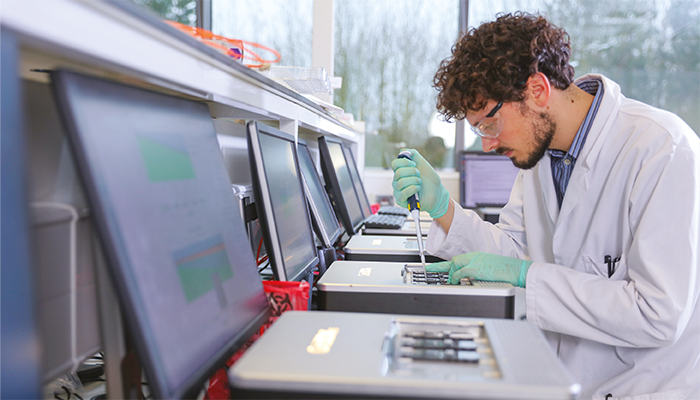
Credit: Supplied by Interviewee
Messenger RNA (mRNA) molecules have become one of the hottest areas of drug development. mRNA allows the human body to produce almost any functional protein or peptide, which means it is also a promising tool for preventing and treating many intractable or genetic diseases. In vitro transcribed mRNA can be manufactured quickly and cost-effectively – and advances continue to be made.
As with any drug modality, analytical techniques are crucial to further development. To help improve the analysis of mRNA products, Lonza and Oxford Nanopore have teamed up on a new test for determining multiple critical quality attributes of mRNA using one platform. We spoke to Torsten Schmidt, Head of mRNA Business Unit at Lonza, and Chris Brown, Vice President of Strategic Programmes at Oxford Nanopore, to learn more.
What are the traditional testing methods for mRNA – and what are the drawbacks?
TS: In addition to standard analytical tests, identity, integrity, and purity are usually tested in mRNA-based products using high-performance liquid chromatography (HPLC) or capillary electrophoresis. Performing these analytical tests requires the right equipment setup and highly skilled personnel. The results are often needed immediately on the shop floor – particularly when it comes to identity testing.
mRNA is still a new modality and setting up analytical tests requires a holistic approach to ensure that these products consistently meet the required quality standards. Beyond the compendial testing methods, the sequencing methods currently used require intermediate steps to generate DNA, which is time-consuming and has limitations when modified nucleotides are incorporated in the mRNA molecule.
How did the two companies meet?
TS: The current mRNA testing setup is not sustainable for meeting future regulatory expectations. This modality is continuing to become the lead technology for manufacturing seasonal vaccines and oncology therapeutics. The availability of rapid and reliable sequencing will be mandatory on that journey. For these reasons, we began searching for partners who could provide next-generation sequencing methods – specifically for the mRNA field.
We connected with Oxford Nanopore at an event in Oxford organized by a Swiss investment promotion organization. We have formed a project team and are working together to refine our vision.
How does the Oxford Nanopore technology work?
CB: Oxford Nanopore has developed an electronics-based sequencing technology that offers scalability with real-time data delivery and the ability to elucidate accurate biological data through the analysis of short to ultra-long fragments of native DNA or RNA.
The technology uses nanopores (nano-scale holes) through which an electrical current flows. As a strand of DNA or RNA is fed through the nanopore, the electrical current is blocked to differing degrees depending on the DNA/RNA bases present inside the nanopore. Through the use of artificial neural networks (similar to those used for speech recognition), this electrical signal is turned into the sequence of bases present in real-time. Immediate access to this data permits decisions to be made before an experiment ends, and removes the limitations associated with traditional sequencing technologies.
Oxford Nanopore devices can sequence the native RNA molecule, providing greater insights that allow several quality attributes in mRNA products to be measured simultaneously, at the same manufacturing site, using one technology platform. This collaboration will use the GridION device, a self-contained benchtop device designed to simultaneously run and analyze data from up to five MinION Flow Cells.
Will the technology require any optimization for mRNA?
CB: The potential for the use of nanopore sequencing for mRNA testing has been a possibility ever since the first publication on the capabilities of the technology to sequence RNA molecules directly, co-authored by one of Oxford Nanopore’s principal scientists and technology lead for this collaboration, Libby Snell (1).
Since those early stages, progress has been made in refining the elements of the RNA sequencing methods using the platform and in generating proof of concept studies relating to a wide range of biological applications of interest. A key study from Gunter and colleagues highlighted the potential of nanopore sequencing in the future of mRNA vaccine QC methods (2). Given the increased investment and rapid growth in mRNA vaccine and therapeutic pipelines in the pharma industry, the value of this application for nanopore sequencing technology in an industry setting was just waiting to be explored!
Our collaboration will evaluate the existing nanopore technology for mRNA testing applications in an industry setting, and we will also look for the need for additional optimization, such as customization of analysis or data integration tools.
How would you describe the future of nanopore technology in the mRNA space?
CB: The teams at both companies are excited about how direct RNA nanopore sequencing-based tests will change the landscape of QC testing for mRNA vaccines and therapeutics. If we can reduce the complexity of measuring critical quality attributes (both in terms of the number and type of different methods required), this would have an impact beyond the scope of this collaboration. We hope it will transform how all mRNA manufacturers think about QC testing.
I believe that our technology is very easy to deploy. It has a small footprint (the smallest devices are palm-sized and connect by USB-C to a computer stack or laptop), no expensive optical or fluidic systems are required, and it could pave the way for decentralized or distributed QC testing for mRNA products. We are also developing a sensing platform that has the potential to be adapted for the analysis of other types of molecules, such as proteins – although we can’t give a timeline for this at present.
References
- DR Garalde et al., “Highly parallel direct RNA sequencing on an array of nanopores,” Nat Methods., 15, 201-206 (2018). DOI: 10.1038/nmeth.4577
- HM Gunter et al., “mRNA vaccine quality analysis using RNA sequencing,” Nature Communications, 14 (2023). DOI: 10.1038/s41467-023-41354-y




